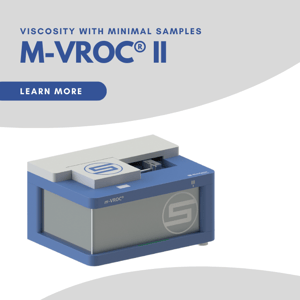
Rheology Tools - Determining Intrinsic Viscosity
Application Note Download
Intrinsic viscosity analysis can be used to examine the molecular structure and interactions of molecules in suspension. It is also a useful parameter for proteins, polymers, and other colloidal suspensions. Intrinsic viscosity measures a solute’s contribution to viscosity at infinite dilution and can be used to calculate molecular size, molecular weight, and molecular stability.
The intrinsic viscosity protocol involves measurement of a concentration series in the dilute regime. The analysis is simplified in the dilute limit since viscosity can be expressed as a series expansion in concentration. The coefficients can then be used to quantify the individual protein contribution and the pair or protein-protein interactions (PPI).
In this application note we create an easy-to-follow protocol for intrinsic viscosity analysis performed on a Bovine gamma globulin (BγG) solution prepared with Acetate buffer. This protocol steps through the derivation of intrinsic viscosity, and the process to calculate the intrinsic viscosity and Huggins coefficient using both conventional data software and RheoSense Clariti™ software.

.jpeg?width=300&name=Woman%20scientist%2c%20documents%20and%20hands%20writing%20_575258496-min(1).jpeg)


.png?width=200&height=58&name=RheoSense%20Logo%20(REGISTERED).png)



